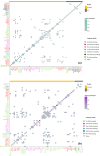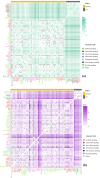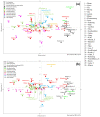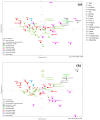South Asian maternal and paternal lineages in southern Thailand and the role of sex-biased admixture
- PMID: 37708147
- PMCID: PMC10501589
- DOI: 10.1371/journal.pone.0291547
South Asian maternal and paternal lineages in southern Thailand and the role of sex-biased admixture
Abstract
Previous genome-wide studies have reported South Asian (SA) ancestry in several Mainland Southeast Asian (MSEA) populations; however, additional details concerning population history, in particular the role of sex-specific aspects of the SA admixture in MSEA populations can be addressed with uniparental markers. Here, we generated ∼2.3 mB sequences of the male-specific portions of the Y chromosome (MSY) of a Tai-Kadai (TK)-speaking Southern Thai group (SouthernThai_TK), and complete mitochondrial (mtDNA) genomes of the SouthernThai_TK and an Austronesian (AN)-speaking Southern Thai (SouthernThai_AN) group. We identified new mtDNA haplogroups, e.g. Q3, E1a1a1, B4a1a and M7c1c3 that have not previously reported in Thai populations, but are frequent in Island Southeast Asia and Oceania, suggesting interactions between MSEA and these regions. SA prevalent mtDNA haplogroups were observed at frequencies of ~35-45% in the Southern Thai groups; both of them showed more genetic relatedness to Austroasiatic (AA) speaking Mon than to any other group. For MSY, SouthernThai_TK had ~35% SA prevalent haplogroups and exhibited closer genetic affinity to Central Thais. We also analyzed published data from other MSEA populations and observed SA ancestry in some additional MSEA populations that also reflects sex-biased admixture; in general, most AA- and AN-speaking groups in MSEA were closer to SA than to TK groups based on mtDNA, but the opposite pattern was observed for the MSY. Overall, our results of new genetic lineages and sex-biased admixture from SA to MSEA groups attest to the additional value that uniparental markers can add to studies of genome-wide variation.
Copyright: © 2023 Woravatin et al. This is an open access article distributed under the terms of the Creative Commons Attribution License, which permits unrestricted use, distribution, and reproduction in any medium, provided the original author and source are credited.
Conflict of interest statement
NO authors have competing interests.
Figures







References
Publication types
MeSH terms
Substances
LinkOut - more resources
Full Text Sources
Miscellaneous

